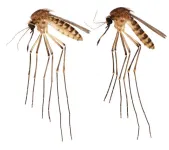(Press-News.org) Another new mosquito species has made its way across the tropics into Florida, making a permanent home in at least three counties. Scientists are concerned because of the rate of new mosquitoes arriving in Florida and the potential for them to transmit mosquito-borne diseases.
A mosquito known only by its scientific name, Culex lactator, is the latest to establish in the Sunshine State, according to a new study published in the Journal of Medical Entomology by faculty at the UF/IFAS Florida Medical Entomology Laboratory (UF/IFAS FMEL).
This species was first discovered in Miami-Dade County in 2018 by UF/IFAS faculty while they hunted for other nonnative mosquitoes. Since then, thriving populations have been recorded in Miami-Dade, Collier and Lee counties. Scientists are concerned there hasn’t been enough research on the species and their potential disease risk.
“There are about 90 mosquito species living in Florida, and that list is growing as new mosquito species are introduced to the state from elsewhere in the world,” said Lawrence Reeves, lead author of the study and an assistant professor and mosquito biologist at the UF/IFAS research center in Vero Beach.
Mosquitoes are among the most studied insects because they can transmit diseases. However, there are large gaps of knowledge, said Reeves.
“That’s particularly true for species from the tropical forests, where mosquitoes are diverse and understudied,” he said. “Introductions of new mosquito species like this are concerning because many of our greatest mosquito-related challenges are the result of nonnative mosquitoes, and in a case like this, it’s difficult to anticipate what to expect when we know so little about a mosquito species.”
Globally, there are more than 3,600 types of mosquitoes. When a new mosquito is found in Florida, it could be any of these species. Reeves and his team used DNA analysis and other tools to not only discover they had found a new mosquito species, but to identify it as Culex lactator.
Culex lactator is found in Central America and northern South America and is a member of the Culex group of mosquitoes. This group includes important species that transmit the West Nile and St. Louis encephalitis viruses, but it is unclear whether Culex lactator will contribute to the transmission of these viruses in Florida.
Every year, Florida faces challenges from mosquito-transmitted diseases like West Nile virus, eastern equine encephalitis virus, dengue virus, chikungunya virus and others, explained Reeves.
“It’s too early to know whether Culex lactator will exacerbate these challenges, but the implications are often difficult to predict because not all mosquito species are equally capable of transmitting a particular virus or other pathogen,” said Reeves.
Each mosquito-borne virus is transmitted by only certain mosquito species, said Reeves.
“We need to be vigilant for introductions of new mosquito species because each introduction comes with the possibility that the introduced species will facilitate the transmission of a mosquito-transmitted disease,” he said.
The initial specimens of Culex lactator were collected in 2018 from rural sites in southern Miami-Dade County, south of Florida City, followed by additional adult and immature specimens collected through 2022 in the same locations. Each set of mosquitoes were collected from traps set by associate professor Nathan Burkett-Cadena, doctoral student Kristin Sloyer and Reeves while looking for other recently introduced mosquitoes.
In 2022, scientists with the Collier Mosquito Control District and Lee County Mosquito Control District found Culex lactator in their counties, indicating that Culex lactator has likely spread from its initial point of introduction.
Currently, Culex lactator is known to live in Collier County – south and west of Naples – Lee County, west of Fort Myers, and in the Homestead area of Miami-Dade County, though it may have also spread elsewhere in the state, said Reeves.
“Culex lactator is physically similar to mosquito species already known from Florida. It looks like other more common mosquito species,” said Reeves. “Because of that similarity, the presence of Culex lactator in an area can be easy to miss.”
Reeves and his team stress it’s important to monitor for Culex lactator as it is likely to spread within the state into areas that are environmentally suitable.
Florida’s proximity to the tropics and climate conditions make it ideal for nonnative mosquito species. Scientists are concerned about the rate and frequency of new species establishing in Florida. As many as 17 nonnative mosquito species are established in the state. Researchers stress that the detections of nonnative mosquito species are increasingly frequent, with 11 of 17 nonnative species first reported in the past two decades, and six of these 17 detected in only the past five years, said Reeves.
The mosquitoes Aedes aegypti, Aedes albopictus, and Culex quinquefasciatus – among the most important disease vectors in the United States – like Culex lactator, are nonnative species, introduced from the tropics.
“Climate change may improve the chances of tropical mosquito species becoming established once they make it to Florida if the state becomes warmer,” adds Reeves. “Increasing storm frequency and intensity could also blow in more mosquitoes and other species from the Caribbean, Central America and elsewhere.”
END
New mosquito species reported in Florida
2023-03-22
ELSE PRESS RELEASES FROM THIS DATE:
New simulation reveals secrets of exotic form of electrons called polarons
2023-03-22
A new leaf has turned in scientists' hunt for developing cutting-edge materials used in organic light-emitting diode (OLED) TV's, touchscreens, and more. The advance involves the polaron, a quasiparticle consisting of an electron and its surrounding distortions of atoms in a crystal lattice.
Simulations on the Texas Advanced Computing Center's (TACC) Frontera supercomputer have helped scientists map for the first time the conditions that characterize polarons in 2D materials, the thinnest materials that have ever been made.
"We charted a map to indicate in which materials polarons should be found, under what conditions, and the characteristics ...
New survey finds COVID-19 pandemic changed public’s view of obesity
2023-03-22
Nearly a third of Americans (29%) say COVID-19 made them more worried than ever about having obesity prompting about 28 million people to consider weight-loss methods they hadn’t thought about before the pandemic began, including nearly 6.4 million thought about turning to either weight-loss surgery or taking prescription anti-obesity drugs for the first time, according to a new survey whose findings were published online in the peer-reviewed journal, Surgery for Obesity and Related Diseases (SOARD).
Another nearly 1 in 5 people (18%) said they were more likely to initiate a discussion about their weight with their physician specifically because ...
Searching for life with space dust
2023-03-22
Following enormous collisions, such as asteroid impacts, some amount of material from an impacted world may be ejected into space. This material can travel vast distances and for extremely long periods of time. In theory this material could contain direct or indirect signs of life from the host world, such as fossils of microorganisms. And this material could be detectable by humans in the near future, or even now.
When you hear the words vacuum and dust in a sentence, you may groan at the thought of having ...
Hunting Venus 2.0: Scientists sharpen their sights
2023-03-22
With the first paper compiling all known information about planets like Venus beyond our solar system, scientists are the closest they’ve ever been to finding an analog of Earth’s “twin.”
If they succeed in locating one, it could reveal valuable insights into Earth’s future, and our risk of developing a runaway greenhouse climate as Venus did.
Scientists who wrote the paper began with more than 300 known terrestrial planets orbiting other stars, called exoplanets. They whittled the list down to the five most likely to ...
New research reveals a potential mechanism for how coffee may reduce the risk of type 2 diabetes
2023-03-22
New scientific research investigates inflammation and insulin resistance in habitual coffee drinkers to understand how coffee may reduce the risk of type 2 diabetes (T2D), mediated by inflammatory biomarkers in the body 1.
Drinking just one additional cup of coffee per day was associated with a 4-6% lower risk of T2D among participants in two large prospective cohort studies, which was partly explained by lower levels of inflammation1.
Experts consider consuming up to 400mg of caffeine (3-5 cups of coffee) per day to be a moderate and safe amount for most adults. For pregnant or lactating women, caffeine intake should be reduced to 200mg per day2.
These results further support previous ...
Big firms are failing to reduce unconscious bias against disabled people
2023-03-22
Working for a big company or in an HR role does not lower the likelihood of showing unconscious bias against disabled people at work, a new study finds.
Researchers say this is ‘surprising’ because of the money many large firms spend on EDI and unconscious bias training – in 2017 up to $8bn in the US alone – and the fact HR professionals are often specifically trained in EDI issues.
The research, a collaboration between the University of Exeter’s Business School and Medical ...
Does birth by cesarean section affect children’s academic performance and intelligence?
2023-03-22
In a study of Danish children born between 1978–2000, chances of graduating from lower and upper secondary education were significantly lower for children born by cesarean section (CS). However, differences in grade point averages and intelligence scores were very small. The study, which is published in Acta Obstetricia et Gynecologica Scandinavica, also found that males born by CS had a lower likelihood of appearing before a conscription board for drafting into the military.
In Denmark, most students are 6–16 years old while in lower secondary education (LSE) and 16–17 years old when initiating ...
Can moderate dietary salt restriction help patients with hypertension?
2023-03-22
Results from a clinical trial published in the Journal of Internal Medicine reveal several health benefits of moderate salt restriction in patients on standard medical treatment for primary aldosteronism.
Primary aldosteronism—a condition in which the adrenal glands make too much of the hormone aldosterone—is a common cause of secondary hypertension. The combination of aldosterone excess and high dietary salt intake leaves affected patients with a higher risk of cardiovascular disease than patients with hypertension ...
How fisheries threaten seals and sea lions in South America
2023-03-22
Seals, sea lions, and fur seals are at risk from interactions with fisheries and aquaculture, as they can become entangled in nets or cages, and drown. In a study published in Mammal Review, investigators analyzed research from the last 25 years on operational and biological interactions between these marine mammals and fisheries and aquaculture activities in South American waters.
The authors found that two species are primarily involved in interactions in many countries: the South American sea lion Otaria flavescens and the South American fur seal Arctocephalus australis. ...
Does care during pregnancy differ based on patient race in the United States?
2023-03-22
In an analysis of perinatal care provided in the United States, investigators found few differences by race for care that was based on guidelines or expert recommendations; however, discretionary care (for which professional recommendations or guidelines do not exist) varied by race.
The analysis, which is published in Birth, included information from the electronic health records for 7,056 women who delivered infants within a large hospital system between 2012 and 2018. Compared with Non-Hispanic white women, Non-Hispanic Black women were ...




